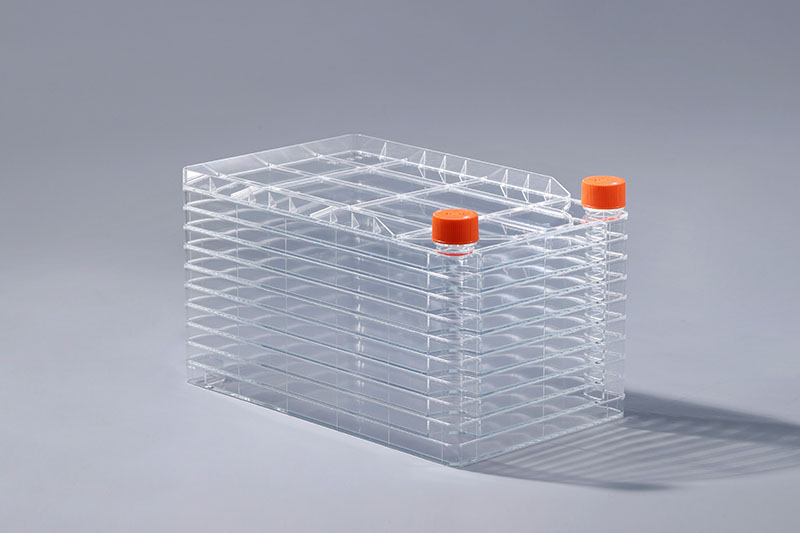은 세포 배양 소모품의 단층 또는 다층 구조입니다. 세포 배양 과정에서 우리는 다음 단계로 진행하기 전에 시간에 따라 세포의 성장 상태를 파악해야 합니다. 생존 가능한 세포의 수는 트립판 블루 염색으로 검출할 수 있습니다. 구체적인 동작 방법은 다음과 같습니다.1. 부착 세포의 경우 배지를 흡인하고 소화 용액을 추가하고 적절한 시간 동안 인큐베이터에서 소화합니다. 세포가 둥글게 된 후, 소화물의 부피와 같거나 더 큰 부피의 배지를 첨가하여 소화를 종료하였다. 원심분리 후 세포 현탁액을 배양 배지로 만듭니다.cell factory
2. 0.5ml 트리판 블루 용액, 0.3ml PBS 및 0.2ml 세포 현탁액을 취하고 잘 섞습니다. 그런 다음 혼합물을 1-2분 동안 방치했습니다. 모세관 피펫 또는 10ul 작은 피펫 팁을 사용하여 혼합물의 소량을 뽑아 혈구계에 주입하십시오.
3. 적어도 1000개의 세포를 세고 염색된 세포의 수를 세십시오.
4. 초순수와 75% 에탄올로 카운팅 플레이트와 커버슬립을 씻으십시오.
5. 정상 세포는 염색되지 않으며 세포가 죽은 후에야 세포막 투과성이 커지고 트리판 블루가 세포에 들어가 세포가 파란색으로 나타납니다. 혼합물을 너무 오래 두지 마십시오. 그렇지 않으면 정상적인 살아있는 세포도 염료를 흡수하여 계산 정확도에 영향을 미칩니다.
6. 세포 생존율(%) = (총 세포 수 - 염색된 세포 수)/총 세포 수*100;
7. 세포 계수법과 마찬가지로 트리판 블루 염색도 오차가 큽니다. 초기 세포사멸 수준만 감지할 수 있을 뿐 대조군과 실험군의 차이를 보여주지는 못한다.
세포 공장에서 세포를 배양하는 과정에서 여러 가지 이유로 죽는 세포가 항상 존재한다. 살아있는 세포의 수와 세포 생존 능력을 마스터하는 것은 세포 배양 실험의 핵심 작업이며 실험의 진행을 보장하는 효과적인 방법입니다.
In the process of culturing cells in a cell factory, there are always some cells that die due to various reasons. Mastering the number of living cells and cell viability is a key operation in cell culture experiments and an effective way to ensure the progress of the experiment.
The FAI climbed 5.9 percent year-on-year in the first 11 months of 2018, quickening from the 5.7-percent growth in Jan-Oct, the National Bureau of Statistics (NBS) said Friday in an online statement.
The key indicator of investment, dubbed a major growth driver, hit the bottom in August and has since started to rebound steadily.
In the face of emerging economic challenges home and abroad, China has stepped up efforts to stabilize investment, in particular rolling out measures to motivate private investors and channel funds into infrastructure.
Friday's data showed private investment, accounting for more than 60 percent of the total FAI, expanded by a brisk 8.7 percent.
NBS spokesperson Mao Shengyong said funds into weak economic links registered rapid increases as investment in environmental protection and agriculture jumped 42 percent and 12.5 percent respectively, much faster than the average.
In breakdown, investment in high-tech and equipment manufacturing remained vigorous with 16.1-percent and 11.6-percent increases respectively in the first 11 months. Infrastructure investment gained 3.7 percent, staying flat. Investment in property development rose 9.7 percent, also unchanged.
 English
English



















































